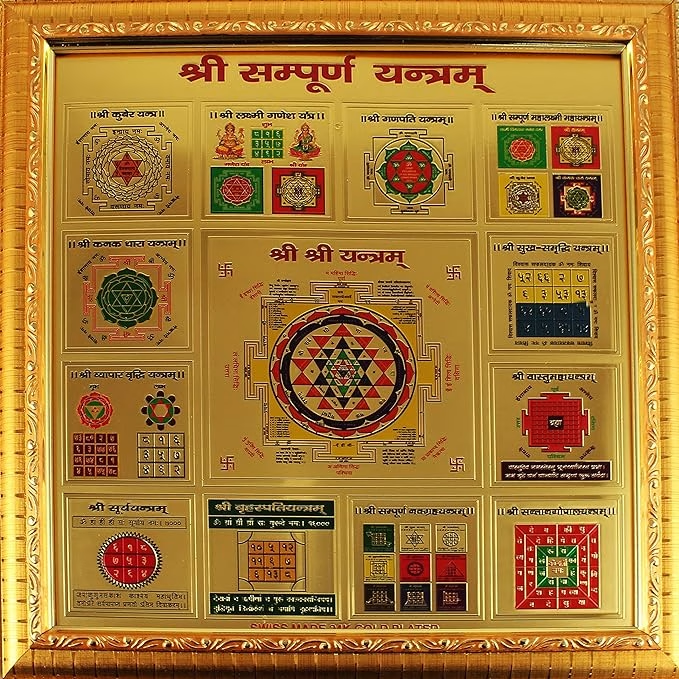Vastu Shastra, often referred to as the "Science of Architecture," is an ancient Indian system that guides the design and layout of buildings to harmonize human life with the natural elements. Rooted in the Vedas, this traditional knowledge combines spiritual beliefs with architectural principles to ensure prosperity, health, and well-being.
📜 Origins of Vastu Shastra
Vastu Shastra is believed to have originated over 5,000 years ago, primarily from texts like the Rig Veda and later detailed in texts such as Mayamatam, Manasara, and Vishwakarma Vastu Shastra. The term “Vastu” means dwelling, and “Shastra” means science or doctrine—together, it translates to “the science of dwellings.”
It was traditionally used in the planning of temples, palaces, towns, and homes to create spaces that align with cosmic energy.

eshoppee shri shree sampoorn sampurna yantra 19 x 19 cm for health wealth and prosperity
| Colour | SAMPURNA |
| Brand | eshoppee |
| Material | Wood |
| Model Name | SHRI SAMPOORN YANTRA |
| Item dimensions L x W x H | 19 x 19 x 0.5 Centimeters |
Only Rs. 244/- Click Here to purchase now
🌐 The Five Elements (Panchabhutas)
Vastu is based on balancing the five natural elements:
- Earth (Prithvi) – Provides stability and support.
- Water (Jal) – Linked with purity and clarity.
- Fire (Agni) – Represents energy, passion, and strength.
- Air (Vayu) – Relates to movement and communication.
- Space (Akash) – Denotes openness and expansion.
Each of these elements is associated with specific directions and must be harmonized within a space for optimal energy flow.
🧭 Directional Principles in Vastu
According to Vastu, different directions are ruled by various elements and deities. Here's how directions align with key areas of a home:
- East (Indra – Sun): Ideal for entrances, living rooms, and prayer rooms.
- North (Kubera – Wealth): Best suited for cash lockers, offices, or study areas.
- South (Yama – Strength): Recommended for bedrooms and storage.
- West (Varun – Water): Good for dining and children’s rooms.
- Northeast (Ishanya): Considered the most sacred; best for meditation or puja rooms.
- Southeast (Agni): Ideal for kitchens.
- Northwest (Vayu): Good for guest rooms.
- Southwest (Nairitya): Suited for master bedrooms and heavy storage.
🏠 Applications of Vastu Shastra
1. Residential Spaces
- Entrance should ideally be in the north or east.
- Kitchen should be in the southeast.
- Bedroom should face southwest.
- Toilets should be in the northwest or southeast but never in the northeast.
2. Commercial Buildings
- Offices should have their main entrance facing north.
- Owner’s cabin should be in the southwest.
- Financial department should be in the north.
- Reception should be in the northeast.
3. Industrial Layouts
- Raw materials should be stored in the southwest.
- Finished goods should be in the northwest.
- Manufacturing areas in the south or west zones.
🧘♀️ Benefits of Following Vastu Shastra
✔️ Brings peace, harmony, and balance to occupants
✔️ Enhances mental clarity and decision-making
✔️ Promotes financial growth and stability
✔️ Improves relationships and family bonds
✔️ Encourages better health and well-being
✔️ Supports career success and business growth
🛠️ Modern Relevance and Adaptation
While some critics consider Vastu a pseudoscience, it remains highly influential in Indian real estate and interior design. Many architects and homebuyers today seek Vastu-compliant properties, believing that such alignment ensures long-term success and peace.
Modern Vastu often blends with architecture and interior design trends to offer practical yet energy-aligned living solutions—without rigid restrictions.
📋 Tips for Vastu-Friendly Living
- Keep the northeast corner clean and clutter-free.
- Use mirrors carefully—never place them in front of the bed.
- Use natural colors (earth tones) on walls.
- Ensure proper ventilation and natural light.
- Place indoor plants in the east or north for positive vibes.
🧑🏫 Do You Need a Vastu Consultant?
If you're building a new home or redesigning your current space, consulting a certified Vastu expert can provide personalized guidance based on the property’s orientation, location, and individual needs. Many experts also offer digital Vastu consultations today.
🔚 Conclusion
Vastu Shastra is more than just a set of architectural rules—it's a holistic approach that emphasizes the well-being of people through harmony with nature. Whether you're a believer or a skeptic, aligning your space with elements of balance, light, and order can positively influence your life.
Our Latest Posts
- Futuristic Tech You’ll Use Daily by 2025 (and After)
- Metaverse, Web 4.0, and AI Will Redefine 2025 and Beyond
- Trends For Entrepreneur Should Prepare For
- Next Gen Tech : What Will Technology Look Like in 2030?
- Tech Forecast: Game-Changing Trends and Predictions
- Tech for Tomorrow: Sustainability and Innovation Beyond 2025







